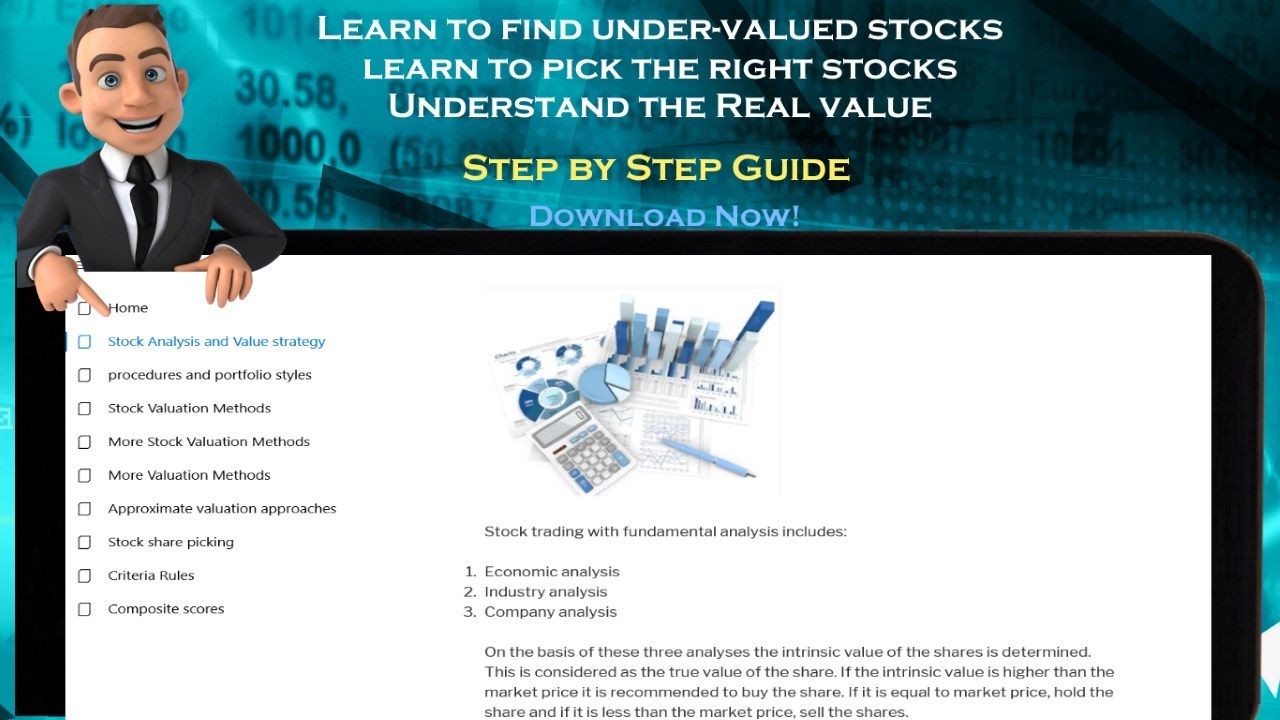


Description
When you buy stocks you may consider several strategies, however value stock analysis is by far the most recommended approach, by greatest and most famous investors in the world.
Value stock analysis or fundamental analysis is the best long-term investing strategy. This is proven again and again in researches and in real life.
fundamental stock analysis maintains that markets may misprice a security (stock, bond, etf, futures, forex etc.) in the short run but that the “correct” price will eventually be reached. Profits can be made by purchasing the mispriced security and then waiting for the market to recognize its “mistake” and reprice the security. This is the main methodology we’re going to study. We will find the right value of a stock by analyzing the company real data and reports, things like earnings, growth, free cash flow and more.
Please be sure that we will teach you everything from scratch, so don’t worry if you don’t know anything about the stock market – that’s about to change.
In our course we have 10 main lesson and more extra and bonus lessons:
✰ procedures and portfolio styles – Fundamental analysis of a business involves analyzing its financial statements and health, its management and competitive advantages, and its competitors and markets. When analyzing a stock, futures contract, or currency using fundamental analysis there are two basic approaches one can use; bottom up analysis and top down analysis. The term is used to distinguish such analysis from other types of investment analysis, such as quantitative analysis and technical analysis.
✰ Stock Valuation Methods – The most important part in financial markets investing, is stock valuation. That means the method of calculating theoretical values of companies and their stocks. The main use of these methods is to predict future market prices, or more generally potential market prices, and thus to profit from price movement – stocks that are judged undervalued (with respect to their theoretical value) are bought, while stocks that are judged overvalued are sold, in the expectation that undervalued stocks will, on the whole, rise in value, while overvalued stocks will, on the whole, fall. Some of the methods you will learn: Earnings Per Share (EPS), Earnings Per Share (P/E), Growth Rate, Price Earnings to Growth (PEG) Ratio, Return on Invested Capital (ROIC), Return on Assets (ROA), Price to Sales (P/S), Market Cap, Enterprise Value (EV), EV to Sales, EBITDA, EV to EBITDA and more!
✰ Approximate valuation approaches - Assuming that two stocks have the same earnings growth, the one with a lower P/E is a better value. The P/E method is perhaps the most commonly used valuation method in the stock brokerage industry. By using comparison firms, a target price/earnings (or P/E) ratio is selected for the company, and then the future earnings of the company are estimated. The valuation’s fair price is simply estimated earnings times target P/E. This model is essentially the same model as Gordon’s model, if k-g is estimated as the dividend payout ratio (D/E) divided by the target P/E ratio.
✰ Stock share picking, Selection components – Learn how to pick the right stock. Stock selection criteria are methods for selecting a stocks for investment. The stock investment or position can be “long” (to benefit from a stock price increase) or “short” (to benefit from a decrease in a stock’s price), depending on the investor’s expectation of how the stock price is going to move.
✰ Criteria Rules – use everything we’ve learned to form one clear strategy, with clear rules. Learn what should the PEG ratio be, the expected growth, debt ration, Institutional ownership, Dividend yields etc. and of course, understand why each of the rules make sense in forming great portfolio and picking the right share / stock.
✰ Learn to use auto screening tools
✰ More bonuses inside!
Download now, boost your financial future!
-
When you buy stocks you may consider several strategies, however value stock analysis is by far the most recommended approach, by greatest and most famous investors in the world.
-
Value stock analysis or fundamental analysis is the best long-term investing strategy. This is proven again and again in researches and in real life.
-
fundamental stock analysis maintains that markets may misprice a security (stock, bond, etf, futures, forex etc.) in the short run but that the “correct” price will eventually be reached.
-
procedures and portfolio styles – Fundamental analysis of a business involves analyzing its financial statements and health, its management and competitive advantages, and its competitors and markets.
-
Stock Valuation Methods – The most important part in financial markets investing, is stock valuation. That means the method of calculating theoretical values of companies and their stocks.
-
Earnings Per Share (EPS), Earnings Per Share (P/E), Growth Rate, Price Earnings to Growth (PEG) Ratio, Return on Invested Capital (ROIC), Return on Assets (ROA), Price to Sales (P/S), Market Cap, etc
-
Approximate valuation approaches - Assuming that two stocks have the same earnings growth, the one with a lower P/E is a better value. The P/E method is perhaps the most commonly used valuation method
-
Stock share picking, Selection components – Learn how to pick the right stock. Stock selection criteria are methods for selecting a stocks for investment. The stock investment or position can be “long
-
Criteria Rules – use everything we’ve learned to form one clear strategy, with clear rules. Learn what should the PEG ratio be, the expected growth, debt ration, Institutional ownership, Dividend yiel
